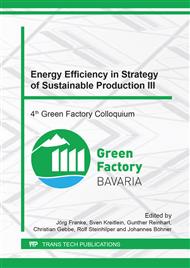[1]
Bundesministerium für Wirtschaft und Energie, Gesetzeskarte für das Energieversorgungssystem.
Google Scholar
[2]
E. Müller, J. Engelmann, T. Löffler, J. Strauch, Energieeffiziente Fabriken planen und betreiben, Springer Berlin Heidelberg, Berlin, Heidelberg, (2009).
DOI: 10.1007/978-3-540-89644-9_4
Google Scholar
[3]
G. Hoogsteen, A. Molderink, J.L. Hurink, G.J. Smit, F. Schuring, B.K. Liandon, Impact of peak electricity demand in distribution grids: A stress test, in: 2015 IEEE Eindhoven PowerTech, p.1–6.
DOI: 10.1109/ptc.2015.7232412
Google Scholar
[4]
BDEW Bundesverband der Energie- und Wasserwirtschaft e.V., Redispatch in Deutschland: Auswertung der Transparenzdaten (2016).
Google Scholar
[5]
Bundesministeriums der Justiz und für Verbraucherschutz, Erneuerbare-Energien-Gesetz vom 21. Juli 2014 (BGBl. I S. 1066), das zuletzt durch Artikel 2 des Gesetzes vom 22. Dezember 2016 (BGBl. I S. 3106) geändert worden ist: EEG (2017).
DOI: 10.1515/9783110900392
Google Scholar
[6]
Information on https: /www. netztransparenz. de/EEG/EEG-Umlage.
Google Scholar
[7]
S. Lehmann, Industriestrompreise: Ausnahmeregelungen bei Energiepreisbestandteilen, (2015).
Google Scholar
[8]
Bundesministerium für Wirtschaft und Technologie, Ein Strommarkt für die Energiewende (Grünbuch).
Google Scholar
[9]
Bundesministerium für Wirtschaft und Energie, Ein Strommarkt für die Energiewende: Ergebnispapier des Bundesministeriums für Wirtschaft und Energie (Weißbuch) (2015).
DOI: 10.5771/9783748907138-263
Google Scholar
[10]
Wissenschaftliche Dienste Deutscher Bundestag, Ausarbeitung. Rechtliche Voraussetzungen für Pilotprojekte zum Grundeinkommen. (2016).
Google Scholar
[11]
L. März (Ed. ), Simulation und Optimierung in Produktion und Logistik: Praxisorientierter Leitfaden mit Fallbeispielen, Springer, Berlin, Heidelberg, (2011).
Google Scholar
[12]
Michael Schenk, Siegfried Wirth, Egon Müller, Fabrikplanung und Fabrikbetrieb, Springer-Verlag, Berlin/Heidelberg, (2004).
Google Scholar
[13]
G. Reinhart, M. Graßl, S. Datzmann, Methode zur Bewertung der Energieflexibilität, wt Werkstattstechnik online (2014) 313–319.
DOI: 10.37544/1436-4980-2014-5-313
Google Scholar
[14]
M. Graßl, Bewertung der Energieflexibilität in der Produktion. Zugl.: München, Techn. Univ., Diss., 2015, Utz, München, (2015).
Google Scholar
[15]
S. Kabelitz, U. Streckfuß, Energieflexibilität in der Produktionstheorie: Ein analytischer Identifikationsansatz, ZWF (2014) 43–45.
DOI: 10.3139/104.111082
Google Scholar
[16]
S. Kabelitz, U. Streckfuß, Identifikation energierelevanter Flexibilitätsdimensionen von Fertigungssystemen, ZWF 109 (2014) 900–903.
DOI: 10.3139/104.111260
Google Scholar
[17]
K. Erlach (Ed. ), Energiewertstrom: Der Weg zur energieeffizienten Fabrik, Fraunhofer-Verl., Stuttgart, (2009).
Google Scholar
[18]
M. Lörcher (Ed. ), Mit der Pinch-Technologie Prozesse und Anlagen optimieren: Eine Methode des betrieblichen Energie- und Stoffstrommanagements, first. Aufl., LfU, Karlsruhe, (2004).
Google Scholar
[19]
C. Brecher, W. Boos, W. Klein, K. Kuhlmann, J. Triebs, Ressourceneffizienzbewertung einer Werkzeugmaschine zur Steigerung ihrer Wirtschaftlichkeit, in: ZWF Zeitschrift für wirtschaftlichen Fabrikbetrieb, 2009, p.711–715.
DOI: 10.3139/104.110151
Google Scholar
[20]
W. Boos, K. Kuhlmann, Bewertung der Ressourceneffizienz von Werkzeugmaschinen, in: wt Werkstattstechnik online, fifth ed., Springer-VDI-Verlag GmbH & Co. KG, Düsseldorf, 2010, p.350–353.
DOI: 10.37544/1436-4980-2010-5-350
Google Scholar
[21]
M. Weskamp, M. Sauer, F. Zwißler, Nachhaltigkeit in der Produktion – eine komplexe Aufgabe, in: Productivity Management, GITO mbH Verlag, 2013, p.25–27.
Google Scholar
[22]
R. Neugebauer (Ed. ), Handbuch ressourcenorientierte Produktion, Hanser, München, Wien, (2014).
Google Scholar
[23]
B. Schieferdecker, C. Fuenfgeld, A. Bonneschky, Energiemanagement-Tools: Anwendung im Industrieunternehmen, Springer, Berlin, (2006).
DOI: 10.1007/3-540-29481-3_2
Google Scholar
[24]
C. Schmid, Energieeffizienz in Unternehmen: Eine wissensbasierte Analyse von Einflussfaktoren und Instrumenten, Vdf, Hochsch. -Verl. an der ETH, Zürich, (2004).
Google Scholar
[25]
H. Seidel, S. Kolomiichuk, Energieträgerübergreifende Modellierung in der Produktion und Logistik - Cross-Energy-Model (CEM), in: H.E. Zsifkovits, S. Altendorfer-Kaiser (Eds. ), Management logistischer Informationsflüsse: 3. Wissenschaftlicher Industrielogistik-Dialog in Leoben (WiLD), Hampp, München, Mering, 2015, p.57.
Google Scholar
[26]
M. Schenk (Ed. ), Produktion und Logistik mit Zukunft: Digital Engineering and Operation, Springer Berlin Heidelberg, Berlin, Heidelberg, (2015).
Google Scholar
[27]
R. Gunther, G. Florian, K. Florian, W. Markus, Handlungsfelder zur Realisierung energieeffizienter Produktionsplanung und –steuerung., in: ZWF Zeitschrift für wirtschaftlichen Fabrikbetrieb, 2011, p.596–601.
DOI: 10.3139/104.110620
Google Scholar
[28]
R. Neugebauer, M. Putz, A. Schlegel, T. Langer, E. Franz, S. Lorenz, Energy-Sensitive Production Control in Mixed Model Manufacturing Processes, in: D.A. Dornfeld, B.S. Linke (Eds. ), Leveraging technology for a sustainable world: Proceedings of the 19th CIRP Conference on Life Cycle Engineering, University of California at Berkeley, Berkeley, USA, May 23-25, 2012, Springer, Heidelberg, New York, 2012, p.399.
DOI: 10.1007/978-3-642-29069-5
Google Scholar
[29]
R. Neugebauer, Untersuchung zur Energieeffizienz in der Produktion: Abschlussbericht, FhG; Technische Informationsbibliothek u. Universitätsbibliothek, München, Hannover, (2008).
Google Scholar
[30]
S. Thiede, Energy efficiency in manufacturing systems, Springer, Berlin, New York, (2012).
Google Scholar
[31]
C. Herrmann, S. Thiede, A. Zein, S. Ihlenfeldt, P. Blau, Energy Efficiency of Machine Tools: Extending the Perspective, in: Proceedings of the 42nd CIRP International Conference on Manufacturing Systems: Proceedings of the 42nd CIRP International Conference on Manufacturing Systems, June 3 - 5, 2009 Grenoble, France, 2009, Grenoble, France, (2009).
DOI: 10.1016/j.cirpj.2009.06.005
Google Scholar
[32]
M. Ester, J. Sander, Knowledge Discovery in Databases: Techniken und Anwendungen, Springer Berlin Heidelberg, Berlin, Heidelberg, (2000).
Google Scholar
[33]
U. Fayyad, G. Piatetsky-Shapiro, P. Smyth, From Data Mining to to Knowledge Discovery in Databases, in: AI Magazine, seventeenth(third), 1996, p.37–54.
Google Scholar
[34]
N. Bissantz, J. Hagedorn, Data Mining (Datenmustererkennung)., in: Wirtschaftsinformatik, thirty-fifth (fifth), 1993, p.481–487.
Google Scholar
[35]
M.R. Berthold, C. Borgelt, F. Höppner, F. Klawonn, Guide to intelligent data analysis: How to intelligently make sense of real data, Springer, London, (2010).
DOI: 10.1007/978-3-030-45574-3
Google Scholar
[36]
B. Küppers, Data Mining in der Praxis: Ein Ansatz zur Nutzung der Potentiale von Data Mining im betrieblichen Umfeld. Zugl.: Graz, Techn. Univ., Diss., 1998, Lang, Frankfurt am Main, (1999).
Google Scholar
[37]
A. Silberschatz, A. Tuzhilin, On Subjective Measures of Interestingness in Knowledge Discovery, in: 1st International Conference on Knowledge Discovery and Data: Proceedings of the 1st International Conference on Knowledge Discovery and Data, Montreal 20-21 August 1195, Montreal, 1995, p.275.
DOI: 10.1002/widm.1063
Google Scholar
[38]
B. Knobloch, Der Data-Mining-Ansatz zur Analyse betriebswirtschaftlicher Daten, Otto-Friedrich-Univ, Bamberg, (2000).
Google Scholar
[39]
G. Linoff, M.J.A. Berry, Data mining techniques: For marketing, sales, and customer relationship management, thirdrd ed., Wiley, Indianapolis, Ind., (2011).
Google Scholar
[40]
Belen'kij. V.M., V.G. Spiridonov, Sravnenie metodov statisticheskogo analiza sravnenie metodov statisticheskogo analiza informacii pri upravlenii bezopasnost'ju truda na proizvodstvennyh ob"ektah, in: Tehnologii XXI veka v legkoj promyshlennosti, seventh ed., (2013).
Google Scholar


